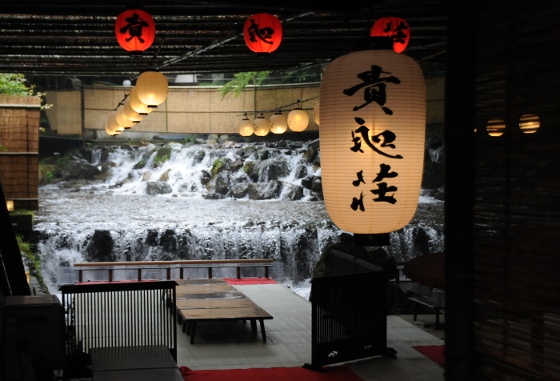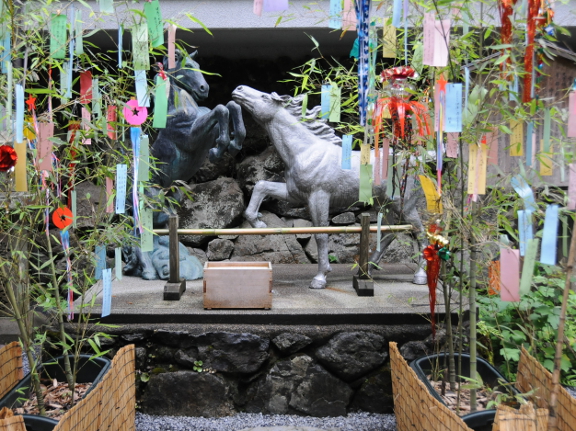Last Thursday I went to Kibune with friends of mine. Kibune is a tiny little village situated in the mountains north of Kyoto. Okay, it’s not really a village – there is not space enough for that. Essentially there is a mountain, then a river, a road, and another mountain. Along a rather short part of the river/road, maybe 4 kilometres, houses were built wherever they could fit – and there is not much space left for this.
 The fact that there is not much space has led to the biggest attraction of Kibune: its kawadoko dining. From June to September, platforms are built over the river where people can sit and have lunch or dinner – always enjoying the natural air-conditioning of the cool water flowing right underneath their seats. Kibune can be as much as 5 degrees cooler than Kyoto, which makes it a welcome retreat for people plagued by the unbearable August heat. Riverside restaurants are expensive since most of them serve kaiseki – Japanese Haute Cuisine – but there are also a few on the other side of the road. There are also a couple of ryokan for people to stay overnight, but since the valley is not very wide, the river is very noisy in parts, and I wonder if you actually can get some rest there.
The fact that there is not much space has led to the biggest attraction of Kibune: its kawadoko dining. From June to September, platforms are built over the river where people can sit and have lunch or dinner – always enjoying the natural air-conditioning of the cool water flowing right underneath their seats. Kibune can be as much as 5 degrees cooler than Kyoto, which makes it a welcome retreat for people plagued by the unbearable August heat. Riverside restaurants are expensive since most of them serve kaiseki – Japanese Haute Cuisine – but there are also a few on the other side of the road. There are also a couple of ryokan for people to stay overnight, but since the valley is not very wide, the river is very noisy in parts, and I wonder if you actually can get some rest there.
 The other great attraction of the village is Kifune Shrine (yes, with an F for some reason). According to myth, it was founded in the early 5th century by the mother of the legendary first emperor Jinmu. She took a yellow boat (Ki-fune) up the river from Osaka, and where she landed, she founded a shrine. It is dedicated to the deity of water and rain, and since the 9th century, people have been worshipping Takaokami-no-kami exclusively as the god who could send rain or withhold it. To appeal to the deity, horses were offered to the shrine, black ones to make it rain, and white ones to stop it.
The other great attraction of the village is Kifune Shrine (yes, with an F for some reason). According to myth, it was founded in the early 5th century by the mother of the legendary first emperor Jinmu. She took a yellow boat (Ki-fune) up the river from Osaka, and where she landed, she founded a shrine. It is dedicated to the deity of water and rain, and since the 9th century, people have been worshipping Takaokami-no-kami exclusively as the god who could send rain or withhold it. To appeal to the deity, horses were offered to the shrine, black ones to make it rain, and white ones to stop it.
 Another, more grisly ritual connected with Kifune shrine is the legendary Ushi-no-toki-mairi. It started out as innocent worship at the shrine in the hour of the ox (between 1 and 3 am), but it changed into a practice to lay a curse on a person. Still done at the same hour, people were supposed to wear headgear with candles and drive nails into a nearby tree – preferably through a straw effigy of the person to be cursed. There are a number of legends dating back to the Kamakura period (1185–1333) and there is even a Noh-play dramatising the story of a scorned woman who, after heeding the advice received at Kifune shrine, turned into a demon to take revenge.
Another, more grisly ritual connected with Kifune shrine is the legendary Ushi-no-toki-mairi. It started out as innocent worship at the shrine in the hour of the ox (between 1 and 3 am), but it changed into a practice to lay a curse on a person. Still done at the same hour, people were supposed to wear headgear with candles and drive nails into a nearby tree – preferably through a straw effigy of the person to be cursed. There are a number of legends dating back to the Kamakura period (1185–1333) and there is even a Noh-play dramatising the story of a scorned woman who, after heeding the advice received at Kifune shrine, turned into a demon to take revenge.
 Even if you don’t seek revenge on anyone, Kibune is worth a visit. The mountains are covered in cedars and cryptomerias, and they are so enormous, that there are places where they reach across both river and road to form a roof of leaves. At this time, the greens are lush and beautiful, but there are also maple trees, which must be a wonderful sight during koyo. It is a bit tough to get there though without a car. The Eizan railway has a stop at Kibune-guchi, and from there it is maybe a 30 minute walk uphill to the shrine. It is worth it though I think, especially in the off hours when there are not many people, the whole setting is very quiet and energising.
Even if you don’t seek revenge on anyone, Kibune is worth a visit. The mountains are covered in cedars and cryptomerias, and they are so enormous, that there are places where they reach across both river and road to form a roof of leaves. At this time, the greens are lush and beautiful, but there are also maple trees, which must be a wonderful sight during koyo. It is a bit tough to get there though without a car. The Eizan railway has a stop at Kibune-guchi, and from there it is maybe a 30 minute walk uphill to the shrine. It is worth it though I think, especially in the off hours when there are not many people, the whole setting is very quiet and energising.
